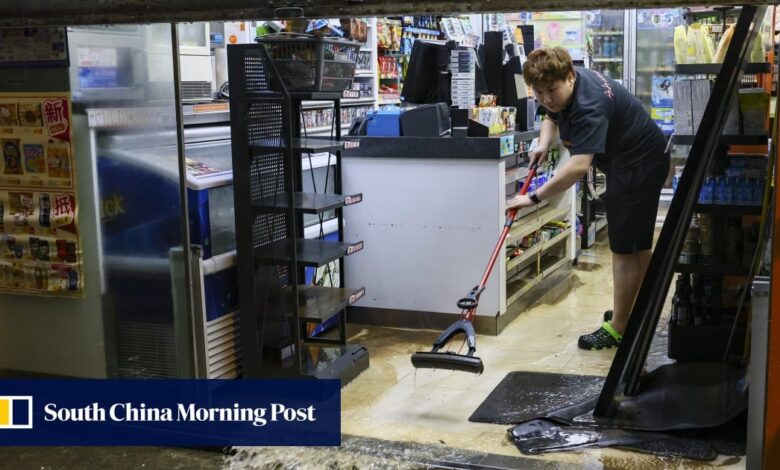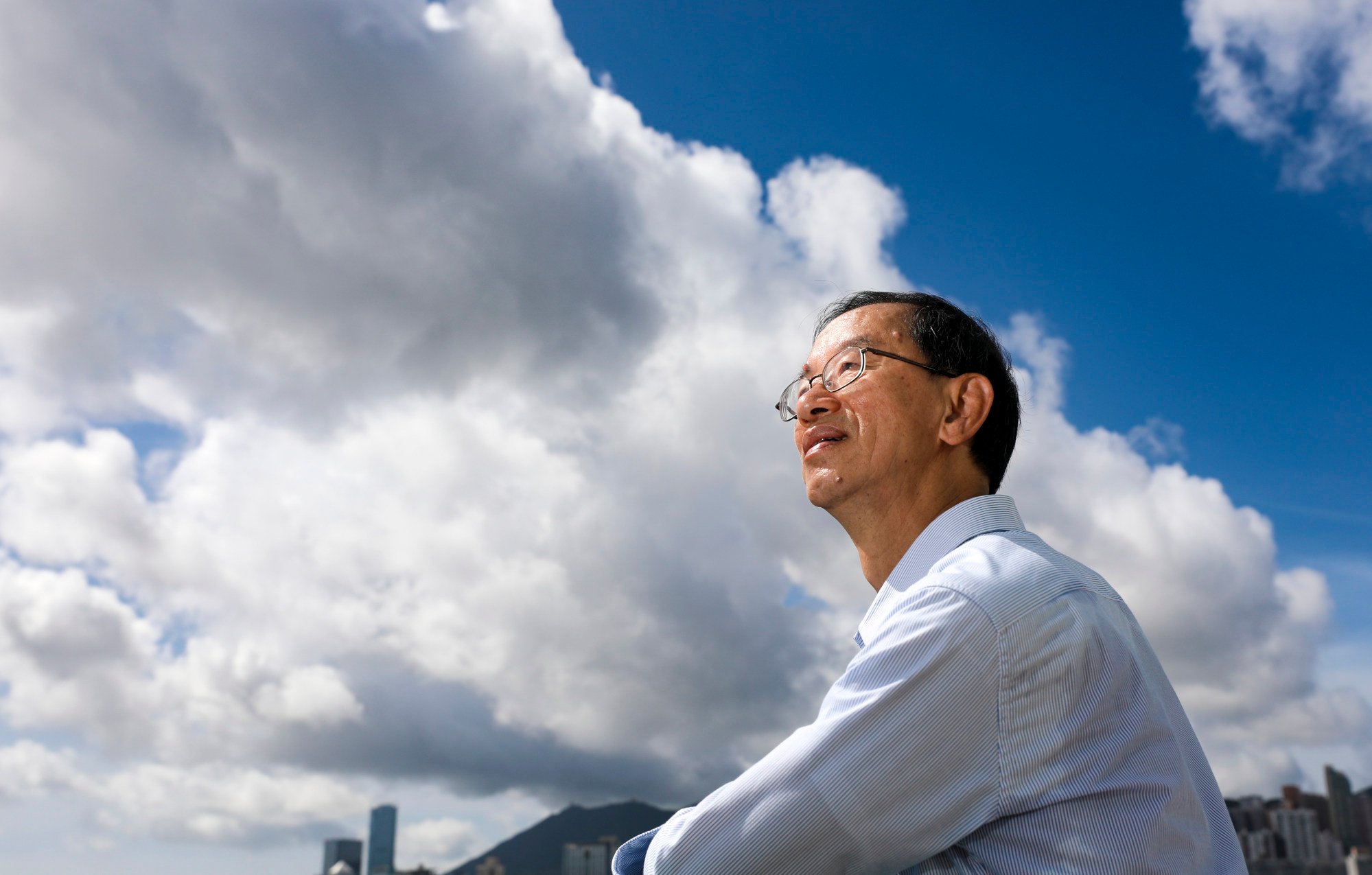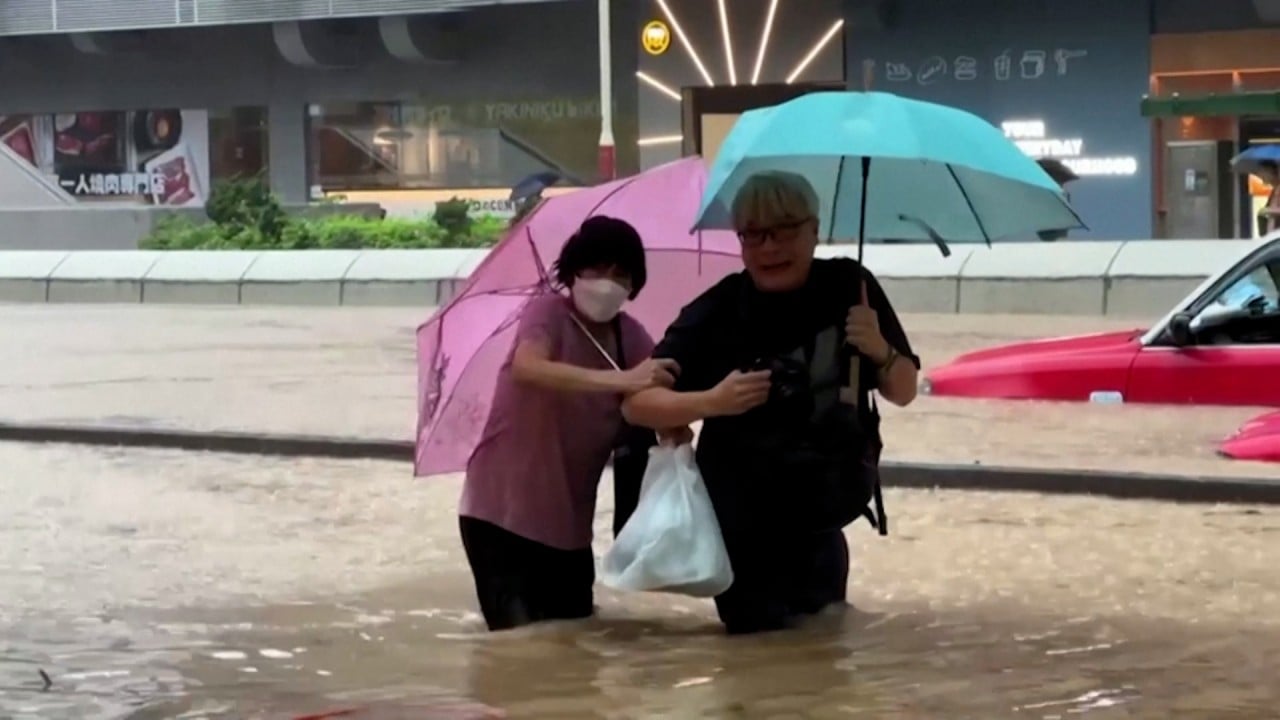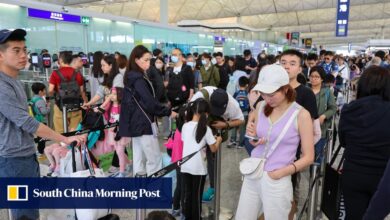Hong Kong floods: experts blame climate change for record rainstorm, warn city must prepare better for more extreme weather events

[ad_1]
More than 600mm of rainfall was recorded, amounting to a quarter of the city’s total annual level, it said.
The black rainstorm warning was in force for more than 16 hours after being raised at 11.05pm on Thursday. Chief Secretary Eric Chan Kwok-ki told a press conference on Friday the storm was a “once-in-500-years” event when he provided details on government efforts to tackle the aftermath of the torrential rain.
Hong Kong Meteorological Society spokesman Leung Wing-mo, a former assistant director at the Observatory, said the probability could be calculated using past rainstorms.
Hong Kong villagers scramble to prepare for reservoir water release amid floods
Hong Kong villagers scramble to prepare for reservoir water release amid floods
“There is a statistical method, which, based on the frequency and intensity of the rainstorms over past years, can reach a so-called distribution, and it can be seen that 158.1mm of rainfall in an hour or 500mm within 24 hours may only occur once in hundreds of years or 500 years,” he said.
More frequent and stronger rainstorms were expected because of global warming, he warned.
The torrential rain brought the city to a standstill, with cars left stranded on flooded roads overnight, some railway stations submerged, and many shops forced to close because of the damage.

Addressing mounting public criticism over a perceived lack of preparedness, Chan said the predictability of rainstorms was “very low” compared with forecasts for typhoons, and the latest one was too big and sudden for authorities to issue warnings early.
Meteorologists said the characteristics of rainstorms, which often formed nearby and within a short period of time, made it impossible to forecast them days ahead. Typhoons, however, could be observed hundreds of kilometres away and forecast a few days in advance.
Leader agrees on need for warning system review for storm-battered Hong Kong
Leader agrees on need for warning system review for storm-battered Hong Kong
“The operation of the rain warning system is very different from the operation of the typhoon warning system. You can follow a typhoon for several days before it hits you, but rainstorms are a very localised phenomenon,” said Lam, adding it was typical that the interval from an amber alert to a red and a black one was short.
“The Observatory tries to anticipate half an hour or one hour ahead of the rainstorms, but going beyond a few hours is practically impossible.”
Leung agreed there were uncertainties involved in forecasting rainstorms.
“Rainstorms can develop quickly … and a completely different situation can arise within an hour or even 30 minutes,” he said.

But meteorologist Clarence Fong Chi-kong at the Macau-based ESCAP/WMO Typhoon Committee under the United Nations said the Observatory could still improve its warning system by closely monitoring rainstorms and alerting residents about areas that could potentially be affected.
He noted the Observatory first issued alerts for heavy rain in the New Territories on Thursday night before an amber warning was raised for the city.
“It was slightly delayed,” Fong said, adding the forecaster could have sent out reminders of potential rainstorms for other parts of the city before the amber alert.

Both Lam and Leung blamed climate change for the torrential rain, calling for better disaster prevention and management for future extreme weather events.
“The record rainfall was no accident, but something expected,” Leung said.
Wong King, a former president of the Hong Kong Institute of Utility Specialists, said rainfall on Thursday night was a “once in a few hundred years” event, but that the city’s drainage system was capable of handling it.
Shek O village residents cut off from rest of Hong Kong as rainstorm damages road
Shek O village residents cut off from rest of Hong Kong as rainstorm damages road
“The main issue is that gullies were blocked by leaves and debris. The water stayed on the road, instead of draining away,” he said.
“Our drainage system can still handle such an amount of water. This also explains why the water has mostly drained away today.”
He said other than garbage, roadside weeds could have caused blockages.
“Under strong winds and rainfall, these weeds break easily and are stuck in gullies following the flowing water,” he said.

Wong said discharge of water from the Shenzhen reservoir and the geographical features of some areas could have been factors in the flooding.
“North district is a low-lying area and water was discharged from the reservoir in Shenzhen. Flooding there was inevitable because the water had nowhere to go,” he said.
“For high ground on Hong Kong Island such as Chai Wan and Pok Fu Lam, the terrain is steep. The drainage system there has no issues but the water was flowing at a high speed and could not drain away in a short period of time. The water would be gone once the rainfall had weakened.”
Hong Kong wakes to submerged roads, landslides amid black rainstorm alert
Hong Kong wakes to submerged roads, landslides amid black rainstorm alert
He said Sheung Wan and Nathan Road in Mong Kok were areas prone to flooding previously, but were not heavily affected this time.
“There are storm water storage tanks being built in those areas where the terrain is relatively flat. When water cannot be dispersed on flat ground, it will be drained to the tanks,” he said.
“As the rainfall weakens, the government will drain the water from the tanks.”

But Aaron Bok Kwok-ming, a former president of the Hong Kong Institution of Engineers, said he believed the large volume of rainfall led to the flooding.
“In terms of facing extreme weather, cities around the world adopt a risk management method. Their drainage systems are designed to cater to a maximum water capacity for once-in-50-years [storms]. As for large-scale systems, they are designed to cater to a capacity of once in 200 years,” he said.
“Within 24 hours [on Thursday], there was around 800mm of rainfall. The rainfall this time was concentrated in Chai Wan and Wong Tai Sin. The amount of rainfall might have exceeded the drainage capacity of these areas.”
‘Mounting anxiety’: caught on the road in Hong Kong’s worst downpour in decades
‘Mounting anxiety’: caught on the road in Hong Kong’s worst downpour in decades
Bok said to prevent future flooding, warnings should be issued earlier and preparation works such as evacuation and installing water-stop boards carried out.
He said as extreme weather might become more frequent, the government would need to strike a balance between economic risks and underground space when considering whether to upgrade drainage capacity so that it was capable of handling once-in-500-years floods.
Institution president Barry Lee Chi-hong said two flood discharge systems were built in Happy Valley and Sheung Wan, not heavily hit Chai Wan.
Johnny Cheuk Chi-yin, a former chairman of the institution’s geotechnical division, said one short-term measure to enhance the capacity of stormwater storage would be to build drainage tunnels through mountains.
[ad_2]
Source link






